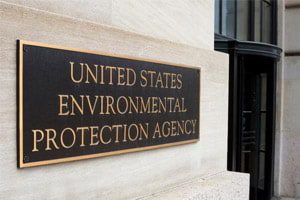
A lawsuit by Public Employees for Environmental Responsibility (PEER) and one of its own chemists has forced the Environmental Protection Agency (EPA) to consider whether to dramatically adjust corrosive dust limits to prevent the kind of lung damage suffered by 9/11 first responders, recovery workers, and area residents. The lawsuit alleges that the EPA’s toxic […]

EPA Forced to Reassess Outdated Toxic Dust Rules
A lawsuit by Public Employees for Environmental Responsibility (PEER) and one of its own chemists has forced the Environmental Protection Agency (EPA) to consider whether to dramatically adjust corrosive dust limits to prevent the kind of lung damage suffered by 9/11 first responders, recovery workers, and area residents.
The lawsuit alleges that the EPA’s toxic dust standard is scientifically inaccurate and jeopardizes the lives of workers and the public.
Dr. Cate Jenkins, an EPA chemist, has long asserted that the agency’s dust standard is scientifically inaccurate. Ten years after the 9/11 attacks, PEER and Dr. Jenkins filed a formal rulemaking petition urging the EPA to correct the corrosivity standard. Three years after the petition was filed, when the EPA still had not acted, PEER filed for a writ of mandamus before the U.S. Court of Appeals for the D.C. Circuit, seeking to force the agency to act. On October 8, 2014, the court ordered the EPA to respond to the petition, according to a PEER news release. In a court filing in March, the EPA pledged to act on the petition by March 31, 2016 with “an advanced notice of proposed rulemaking, a proposed rule, or a tentative determination to deny the petition.” The court directed the EPA “to file status reports at 120-day intervals beginning July 13, 2015.” The EPA has published contract assignments that will provide the technical basis for new standards.
PEER Senior Counsel Paula Dinerstein said, “EPA can no longer hide from this serious public health concern; it finally has to act.” If the EPA fails to correct the corrosive dust safety limits, it will be vulnerable to another lawsuit. “Getting agencies like EPA to admit they have been wrong, especially when many people have died as a result, is no small undertaking,” Dinerstein said.
The EPA’s current dust regulation is 35 years old and, according to PEER, it is ten times less stringent than safe levels for alkaline corrosives set by the United Nations, the European Union, and Canada. Alkaline corrosive dust released during building demolition and cement manufacturing can reach levels that can cause chemical burns, especially to respiratory tissue. But under current EPA standards these dangerous levels are exempt from hazardous waste regulations. The agency has never issued a warning to the public about the corrosive properties of dust from implosion demolitions of large buildings. The two World Trade Center towers imploded following the 9/11 attacks. In addition, PEER says the current EPA standard makes a false distinction between water- and non-water-containing materials. The standard overlooks the fact that water-free alkaline materials quickly absorb water from body tissues, particularly the respiratory tract, on human contact. This can result in irreversible chemical burns, particularly after inhalation. PEER says the standards do not recognize that corrosive dust kills or immobilizes ciliary cells lining the throat and upper respiratory tract, allowing other toxic materials to directly reach deep inside the lungs.
PEER’s Dinerstein said, “We should be grateful that Dr. Jenkins had the courage and perseverance to endure much official backlash in order to bring these public health protections in line with the rest of the world and with sound science.”


